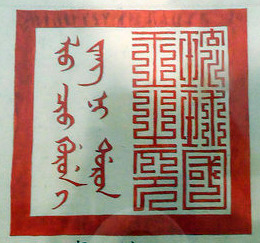Difference between revisions of "Ryukyuan royal seal"
(Created page with "right|thumb|300px|The royal seal of the [[Ryukyu Kingdom|Ryûkyû Kingdom during the Qing Dynasty, showing Chinese characters (琉...") |
(No difference)
|
Revision as of 15:51, 11 December 2017

- Japanese/Chinese: 琉球國王之印 (Ryûkyû kokuô no in / Liúqiú guówáng zhī yìn)
The royal seal of the Kingdom of Ryûkyû was bestowed upon the kingdom by the Chinese court as part of the Ming and Qing Dynasties' investiture of the Ryukyuan king. This was a standard element of the tributary-investiture system; seals like it were granted to all of China's major tributaries.[1] It was used to authorize official documents, both within the kingdom, and in communications with foreign courts.
The kingdom was first granted an official seal by the Hongwu Emperor of the Ming Dynasty in the 1370s, following the kingdom of Chûzan sending a formal tribute mission for the first time in 1372.
Crown Prince Shô Tei journeyed to China in 1654 and returned the royal seal bestowed upon the kingdom by the Ming, receiving an official seal from the Qing in its place.[2]
References
- ↑ David C. Kang, “Hierarchy in Asian International Relations: 1300-1900.” Asian Security 1, no. 1 (2005): 62.; Anthony Reid, "Introduction," in Reid & Zheng Yangwen (eds.), Negotiating Asymmetry: China's Place in Asia (NUS Press, 2009), 13-14.
- ↑ Angela Schottenhammer, “Empire and Periphery? The Qing Empire’s Relations with Japan and the Ryūkyūs (1644–c. 1800), a Comparison.” The Medieval History Journal 16, no. 1 (April 1, 2013): 176-179.